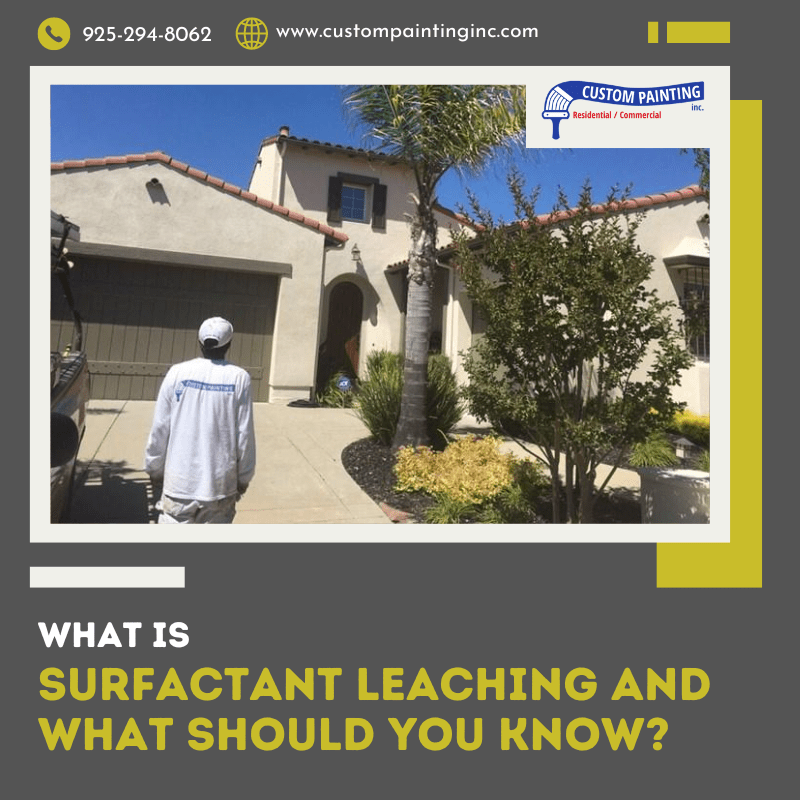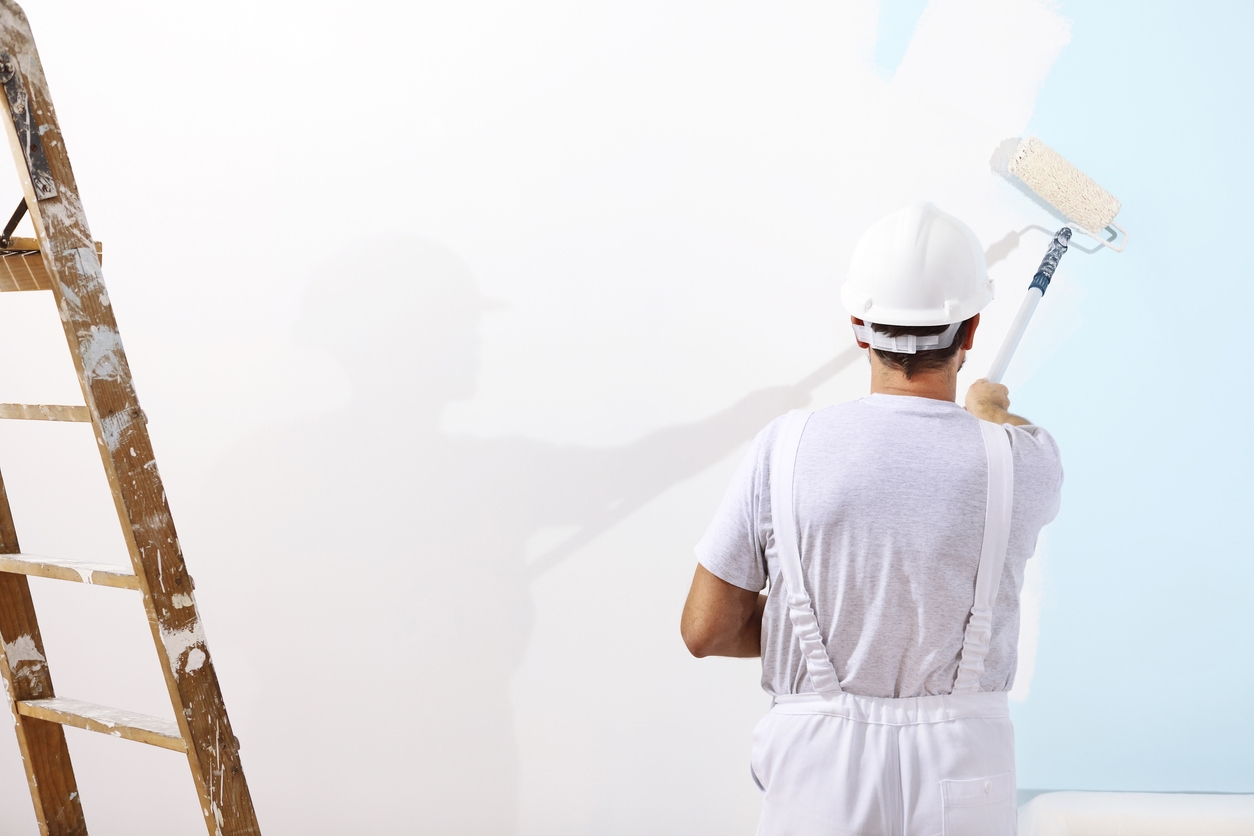Surfactant leaching is a common issue in freshly painted surfaces caused by the migration of surfactants from the paint to the surface as it dries. This problem manifests as streaks or shiny, oily spots on painted walls. These problems which can become apparent once the paint has dried for homes and businesses in the Fremont, Union City, Milpitas, Sunol, Newark, San Jose, Sunnyvale, Santa Clara, and Mountain View areas.
Understanding and addressing surfactant leaching is crucial, particularly for commercial properties where maintaining a high-quality, aesthetically pleasing finish is essential for appearance and longevity.
What is surfactant leaching?
Surfactant leaching refers to the formation of streaks or shiny patches on a painted surface due to the migration of surfactants to the surface as the paint dries. This phenomenon typically happens when the paint has not dried or cured completely, causing surfactants to rise to the top layer.
Role of surfactants
Surfactants are essential components in water-based paints that enhance application, consistency, and flow. They help paint spread evenly and improve its performance during application. However, when these surfactants migrate to the surface, they can cause visible issues.
Appearance
Surfactant leaching often appears as oily, sticky, or glossy stains on the surface. It is usually more prominent on darker or flat paint finishes, which can make the issue more noticeable.
Causes of surfactant leaching
Surfactant leaching occurs when surfactants rise to the surface, thus creating a visible residue. Here’s how different conditions contribute to this issue:
- High humidity: In high-humidity environments, the air holds more moisture, which slows down the drying process of paint. As the paint remains wet longer, surfactants can migrate to the surface and form streaks or a cloudy appearance.
- Cold temperatures: Cool conditions also delay the drying time of paint. The slower evaporation rate allows surfactants to accumulate on the surface, leading to leaching. Thus, cold temperatures can exacerbate the problem by prolonging the time paint remains in a vulnerable state.
- Excessive moisture: Areas with high moisture exposure, like kitchens, bathrooms, or exterior walls, are more prone to surfactant leaching. Moisture can interact with the paint film and disrupt the drying process, leading to the surfactants rising to the surface and causing streaks or discoloration.
- Poor ventilation: In poorly ventilated spaces, the lack of airflow hampers the evaporation of solvents in the paint. This extended drying time allows surfactants more opportunity to migrate to the surface, increasing the likelihood of leaching and resulting in an uneven finish.
Identifying surfactant leaching
- Visual signs: Surfactant leaching can be identified by brownish or oily streaks, blotches, or glossy patches on the painted surface. These signs appear as a result of the surfactants in the paint migrating to the surface and reacting with moisture.
- Areas most affected: Leaching is more likely to occur in high-humidity areas like bathrooms, kitchens, and laundry rooms. It can also affect freshly painted exterior walls exposed to rain or dew shortly after application.
- Timing: Surfactant leaching typically happens shortly after the paint dries, particularly in high-humidity or low-temperature conditions, potentially preventing the paint from fully curing and drying.
Is surfactant leaching harmful?
Surfactant leaching, while unsightly, is generally not harmful to the structural integrity of your paint job. It mainly affects the appearance and does not damage the paint’s adherence or the underlying surface.
- No structural damage: Surfactant leaching is primarily a cosmetic issue that does not compromise the paint’s integrity or damage the surface beneath.
- Easily remedied: Surfactant leaching can usually be addressed by proper cleaning. Often, it will naturally dissipate over time with exposure to air and light.
- Paint longevity: Though it may be visually unappealing, surfactant leaching does not affect the long-term durability of the paint if it is cleaned and maintained correctly.
Preventing surfactant leaching
To prevent surfactant leaching, follow these crucial tips:
- Choose the right conditions: Paint in moderate temperatures and low humidity for optimal drying conditions. Doing so helps prevent moisture from causing surfactants to rise to the surface.
- Proper ventilation: Ensure good ventilation during and after painting to speed up drying. Adequate airflow helps the paint cure faster and reduces the risk of surfactant leaching.
- Quality paint selection: Choose high-quality paints with refined formulations. These are less prone to surfactant leaching and offer better overall performance.
- Allow adequate drying time: Ensure each coat of paint is dry completely before applying additional layers. This step is crucial in humid environments where drying can be slower.
How to fix surfactant leaching?
Surfactant leaching occurs when surfactants in paint or coatings migrate to the surface and appear as a soapy, greasy residue. It can happen in both interior and exterior applications. Here’s a guide on how to address surfactant leaching:
1. Cleaning the surface
- Mild soap and water: Start by gently cleaning the affected area. Mix mild soap with water and use a soft sponge or cloth to wipe the surface. Avoid harsh chemicals or scrubbing too hard, as this might damage the paint or coating.
- Natural dissipation: In some cases, surfactant leaching may resolve on its own over time. Exposure to air and sunlight, especially for exterior surfaces, can help the residue dissipate naturally. Regular exposure to these elements helps the leached substances evaporate.
2. Repainting if necessary
- Repainting: If cleaning does not eliminate the leaching, you may choose to repaint it. Ensure that the surface is thoroughly dry before applying a new coat of paint. It is crucial to avoid trapping moisture or residues beneath the new layer.
- Using high-quality primers: When repainting, use a high-quality primer to seal the surface. This step is important because a good primer will help prevent further surfactant leaching and improve the adhesion of the new paint. Choose primers designed to address specific issues like surfactant leaching or moisture problems.
Following these steps should help you effectively manage and correct surfactant leaching. If the problem persists or is widespread, it may be beneficial to consult a professional for further advice and potential solutions.
Why hire a professional painter to address surfactant leaching
Hiring professional painters to address surfactant leaching is a wise decision for several reasons:
- Expert assessment: Professional painters have the expertise to accurately diagnose surfactant leaching and differentiate it from other paint issues. This ensures the underlying problem is correctly identified and the appropriate solution is applied. Their experience helps avoid misdiagnosis and the potential for repeated issues.
- Proper application and timing: Professionals are well-versed in the ideal conditions for painting, including temperature, humidity, and surface preparation. They understand how these factors influence drying and curing processes, which helps prevent surfactant leaching—a common problem when paint dries too slowly or unevenly due to poor environmental conditions.
- High-quality products: Professional painters have access to high-quality paints and tools that are less prone to issues like surfactant leaching. They use products designed to provide a durable, long-lasting finish and apply them with the correct techniques to ensure the best results.
- Efficient fixes: Should surfactant leaching occur, professional painters can quickly and effectively address the problem. They have the skills and knowledge to repair or repaint affected areas without compromising the project’s appearance, ensuring a seamless and high-quality finish.
Professional painters bring expertise, high-quality materials, and efficient problem-solving skills to prevent and address surfactant leaching, leading to a more durable and visually appealing result.
Conclusion
Surfactant leaching refers to the formation of streaks or shiny patches on a painted surface due to the migration of surfactants to the surface as the paint dries. High humidity, cold temperature, excessive moisture, or poor ventilation can cause surfactant leaching. While it can be unsightly, surfactant leaching generally affects your paint’s appearance and does not damage your paint job’s integrity, adherence, or underlying surface.
To prevent and address this problem effectively, homeowners and commercial property managers should consult a professional painter. Experts can provide tailored solutions and ensure your painting project achieves a smooth, flawless finish. There are many challenges that can come with any project such as stucco painting and repair, rusty door painting and more.
For expert advice and top-notch painting services, don’t hesitate to contact Custom Painting, Inc. today. Call us at 925-866-9610 or message us on our contact page for a free consultation and estimate. Let’s work together to make your next project a success!




